Confederados
Os Confederados | |
|---|---|
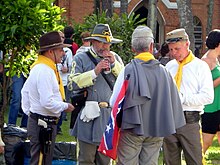 Os Confederados at Festa Confederada | |
| Total population | |
| Thousands of descendants across Brazil[1] | |
| Regions with significant populations | |
| Americana · Santa Bárbara d'Oeste | |
| Languages | |
| English (Southern American English) · Portuguese | |
| Religion | |
| Protestantism · Irreligion | |
| Related ethnic groups | |
| White Southerners and Black Southerners |
Confederados (Portuguese pronunciation: [kõfedeˈɾadus]) is the Brazilian name for Confederate expatriates, all white Southerners (along with their Black slaves), who fled the Southern United States during Reconstruction, and their Brazilian descendants. They were enticed to Brazil by offers of cheap land from Emperor Dom Pedro II, who had hoped to gain expertise in cotton farming. The regime in Brazil had a number of features that attracted the Confederados, namely the continued legality of slavery, but also political decentralization and a relatively high commitment to free trade. [2]
It is estimated that up to 20,000 American Confederates immigrated to the Empire of Brazil from the Southern United States after the American Civil War. Initially, most settled in the current state of São Paulo, where they founded the city of Americana, which was once part of the neighboring city of Santa Bárbara d'Oeste. The descendants of other Confederados would later be found throughout Brazil.
The center of Confederado culture is the Campo Cemetery in Santa Bárbara d'Oeste, where most of the original Confederados from the region were buried. Because of their Protestant religion, they could not be buried in a Catholic cemetery, so they created their own cemetery, the first non-Catholic, non-indigenous cemetery in Brazil. The Confederado community has also established a Museum of Immigration at Santa Bárbara d'Oeste to present the history of Brazilian immigration and highlight its benefits to the nation.
The descendants still foster a connection with their history through the Fraternity of American Descendants, an organization dedicated to preserving the unique mixed culture. Os Confederados also have an annual festival, called the Festa Confederada, which is used to fund the Campo Cemetery. The festival is marked by Confederate flags, traditional dress of Confederate uniforms and hoop skirts, food of the American South with a Brazilian flair, and dances and music popular in the American South during the Antebellum period.
Although the amount of Confederado descendants living in Brazil today is difficult to estimate, in 2016 they were believed to number in the thousands.[3]
History
[edit]
After the war, many Confederate planters were unwilling to live by the new rules imposed by the Union's victory and the constitutional changes that followed: an end to chattel slavery, a new labor regime, and the loss of political power that came with African-American suffrage. Accustomed to raising cotton with the labor of enslaved people, some looked elsewhere in the Western Hemisphere for a place where their old life could be continued.
"Many persons who, from long habit and fondly cherished theories, have become strongly attached to the institution of African slavery, fancy that in Brazil they will find an opportunity for the permanent use of that system of labor — Brazil and the Spanish possessions being the only two slaveholding communities remaining in the civilized world," the New Orleans Daily Picayune wrote in September 1865.[4]
The Brazilian Emperor Dom Pedro II saw an opportunity in the economic disruption in the southern United States and hoped to build up its cotton production for export to the looms of England and France, which had long relied on the Deep South. The Emperor encouraged the immigration of cotton planters from the former Confederacy to enable that expansion.[5]
Immigration to Brazil
[edit]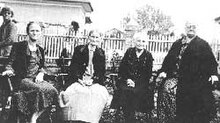
Even before the end of the war in 1865, there was already talk of immigrating to Brazil, but very little was known about this country. After the war ended, there was such a revival of the issue that several emigration companies were formed. Representatives were sent to Brazil to check the land, climate, and facilities offered by the emperor.[6]
In November 1865, the state of South Carolina formed a colonization society and sent Major Robert Meriwether and Dr. H. A. Shaw, among others, to Brazil to investigate the possibility of establishing a colony. On the way back, they published a report mentioning that two lords had already bought land and settled here.[6] Slaves were cheap, they reported.
A confederate from South Carolina, James McFadden Gaston, traveled extensively in central Brazil. Upon return to the US, Gaston published a book titled Hunting a Home in Brazil in 1867. The book was a guide for would-be colonizers and stated in the introduction, "All the requisites of a desirable home have been found in Brazil."[7]
Many Southerners who accepted the Emperor's offer lost their farms and homes during the war, were unwilling to live under occupation by Federal troops during Reconstruction, or simply did not expect an improvement in the Southern economic situation in the foreseeable future. Furthermore, Brazil would not ban slavery until 1888. The Confederates were the first organized Protestant group to settle in Brazil.[6]
Americana and Santa Bárbara d'Oeste
[edit]
On December 27, 1865, Colonel and Senator William Hutchinson Norris of Alabama landed in the port of Rio de Janeiro. In 1866, William and his son Robert Norris climbed the Serra do Mar, stopped in São Paulo and speculated on land. They were offered land for free in what is now the neighborhood of Brás, but he did not accept it because it was marshy. They were also offered the land where São Caetano do Sul is today, and they refused it for the same reason. They decided to go to Campinas, but at the time, the railroad went only 10 miles beyond São Paulo while Campinas is 35 miles further, so the Norrises bought an ox-cart and headed for Campinas. They took 15 days to reach the city, and there they stayed for a while looking for land, until they cast their sights on the plain that stretched from Campinas to Vila Nova da Constituição, current Piracicaba.[8]
The Norrises bought land from the Domingos da Costa Machado sesmaria and established themselves on the banks of Ribeirão Quilombo, at the time belonging to the municipality of Santa Bárbara d'Oeste, today the city of Americana. Upon his arrival, Colonel Norris began to give practical courses in agriculture to farmers in the region, interested in cotton cultivation and new agricultural techniques. The plow he brought from the United States caused so much sensation and curiosity that, within a short time, they had a practical agricultural school, with many students who paid him for the privilege of learning and still cultivating their gardens. The Colonel wrote to his family that he had made US$5,000 from that alone. In mid-1867, the rest of his family arrived, accompanied by many relatives.[8] Many Confederados besides Norris became known for agricultural education and improvement of cotton productivity.[9]
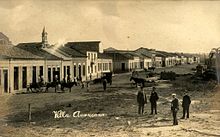
Numerous farms were founded by immigrants from the United States, commemorated today at the Santa Bárbara d'Oeste Immigration Museum.[10] Cultivation and processing of cotton were significant. They established an intense trade, notably from 1875 onwards, with the arrival of the railroad and the installation of the Santa Barbara Station by the Companhia Paulista de Estradas de Ferro. Due to the constant presence of these immigrants, the village that was formed in the vicinity of the Station became known as "Vila dos Americanos", or "Vila Americana", and gave rise to the current city of Americana.[8]
The installation of the Carioba factory by the North American engineer Clement Willmot and Brazilian associates, located one mile from the train station, also dates from this period. Manufacturing played a very important role in the foundation and development of Americana. The education of children was one of the priorities for American families, who set up schools on the properties and hired teachers from the United States. The teaching methods developed by American teachers[clarification needed] proved to be so efficient that they were later adopted by Brazilian official education.[8]
Religious services were celebrated on the properties by pastors who moved between various properties and the various centers of the American diaspora. In 1895 the first Presbyterian Church In Brazil? was founded in the village of Estação. Due to the prohibition of burying people of other faiths in the cemeteries of cities administered by the Catholic Church, American immigrants began to bury their dead near the farmhouse. This cemetery became known as the Campo Cemetery, currently a tourist attraction in the city of Santa Bárbara d'Oeste. Even today the descendants of American families are buried there. It is in this place that descendants gather periodically for religious ceremonies and parties around the 19th-century chapel.[8]
Amazonas
[edit]
Jason Williams Stone, a man from Dana, Massachusetts who moved to Brazil before the American Civil War, made a fortune as a tobacco and rubber farmer. Stone's plantations, which had more than five thousand hectares, were called Colonia Stone. They were located near the city of Itacoatiara, in Amazonas. Many of his descendants still have the surname "Stone". They are found mainly in the cities of Manaus and Itacoatiara, in Amazonas.[11]
Pará
[edit]The city of Santarém, in the state of Pará, received a wave of expatriate families from the American Civil War that took place in the South of the United States. The first to land was the Riker family. In the 1970s, David Afton Riker published a book called The Last Confederate in the Amazon, which chronicles the saga of this migration and life in the new homeland. The Confederates and their descendants became notable in the business and political life of the region.[12]
It is not known how many Confederado immigrants came to Brazil, but unprecedented research in the records of the port of Rio de Janeiro, by Betty Antunes de Oliveira, shows that around 20,000 U.S. citizens entered Brazil between 1865 and 1885.[12]
Descendants of Os Confederados
[edit]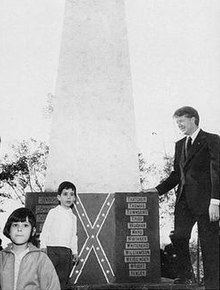
The first generation of Confederates remained an island community. As is typical, in the third generation, most families had already married native Brazilians or immigrants from other origins. Confederate descendants increasingly began to speak the Portuguese language and identify themselves as Brazilians. As the region around the municipalities of Santa Bárbara d'Oeste and Americana became a hub for sugarcane production and society became more mobile, the confederates moved to larger cities in search of jobs in urban areas. Currently, only a few families of descendants still live on land owned by their ancestors. The descendants of the confederates are more spread throughout Brazil. They maintain their organization's headquarters at the Campo Cemetery, in Santa Bárbara d'Oeste, where there is also a chapel and a memorial.
Descendants make a connection to their history through the American Descendant Fellowship, a descendant organization dedicated to preserving immigrant culture. The descendants of the confederates also hold an annual festival in Santa Bárbara d'Oeste called "Festa Confederada", which is dedicated to funding the Campo Cemetery. During the festival, Confederate flags and uniforms are worn, while Southern American food and dances are served and performed. The descendants maintain affection for the Confederate flag, although they identify themselves as fully Brazilian. Many Confederate descendants traveled to the United States at the invitation of Sons of Confederate Veterans, an organization of American descendants, to visit civil war battlefields, participate in reenactments, or visit the places where their ancestors lived.[13]
The Confederate flag in Brazil did not acquire the same political symbolism as it has in the United States. After then-Governor Jimmy Carter's visit to the region in 1972, the government of Americana even incorporated the Confederate flag into its coat of arms (although most of the Italian-descendent population removed it a few years later from the city's official symbol, as the descendants of the Confederates now comprise about a tenth of the city's population). During his visit to Brazil, Carter also visited the city of Santa Bárbara d'Oeste and the grave of a great-uncle of his wife, Rosalynn Carter, at Cemitério do Campo. At the time, Carter noted that Confederate descendants sounded and looked exactly like American southerners.[13]
Today, the Campo Cemetery (and the chapel and memorial located within it) in Santa Bárbara d'Oeste is a memorial, as most of the region's original Confederate immigrants were buried there. As Protestants, they were prohibited by the Catholic Church from burying their dead in local cemeteries and had to establish their own cemetery. The community of descendants also contributed to the Museum of Immigration, also located in Santa Bárbara d'Oeste, to present the history of U.S. immigration to Brazil.[14]
The American immigrants introduced into their new home many new foods, such as pecans, Georgia peanuts and watermelon; new tools such as the iron plow and kerosene lamps; innovations such as modern dentistry, modern agriculture, and the first blood transfusion; and the first non-Catholic churches (Baptist, Presbyterian, and Methodist).[15] Some foods of the American South also crossed over and became part of general Brazilian culture such as chess pie, vinegar pie, and southern fried chicken. The immigrants also established public schools and provided education to their female children, which was unusual in Brazil at the time.
Statistics
[edit]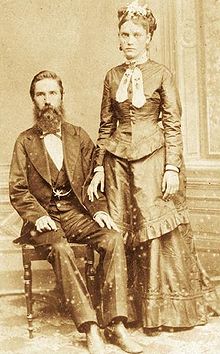
- American immigration to Brazil by State up to January (1867)[16]
| State | Immigrants |
|---|---|
| São Paulo | 800 |
| Espírito Santo | 400 |
| Rio de Janeiro | 200 |
| Paraná | 200 |
| Pará | 200 |
| Minas Gerais | 100 |
| Bahia | 85 |
| Pernambuco | 85 |
| Total | 2,070 |
The Confederate emigres were some 20,000 Southerners, from 12 southern states (e.g. Arkansas, Alabama and Mississippi) who preferred the Brazilian wilderness to life under Union rule after the Civil War.[17]
U.S. ancestry in Brazil
[edit]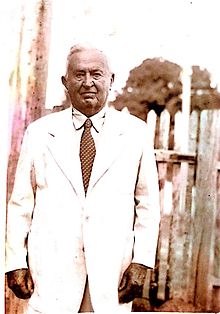
- Number of American descendants by state
| State | Descendants |
|---|---|
| São Paulo | 100,490 |
| Espírito Santo | 50,258 |
| Rio de Janeiro | 25,220 |
| Paraná | 25,000 |
| Pará | 24,800 |
| Minas Gerais | 12,610 |
| Bahia | 10,686 |
| Pernambuco | 10,000 |
| Total | 260,000 |
In popular culture
[edit]Yale University history professor Rollin G. Osterweis wrote Santarem, a novel about Confederados.[18]
See also
[edit]References
[edit]- ^ Romero, Simon (May 8, 2016). "A Slice of the Confederacy in the Interior of Brazil". The New York Times.
- ^ Dean, Aaron Sheehan, ed. (2019). The Cambridge History of the American Civil War: Volume II: Affairs of the State. New York: Cambridge University Press. p. 327. ISBN 9781107154537.
- ^ Romero, Simon (May 8, 2016). "A Slice of the Confederacy in the Interior of Brazil". The New York Times. ISSN 0362-4331. Retrieved June 1, 2024.
- ^ "Emigration to Brazil". The Daily Picayune. September 14, 1865. p. 2. Archived from the original on January 24, 2022. Retrieved January 24, 2022.
- ^ "Confederados forge new cultural identity – Washington Times". Internet Archive. Archived from the original on February 16, 2011.
- ^ a b c "Confederates in Brazil – Article". mason.gmu.edu. Archived from the original on July 8, 2007. Retrieved January 15, 2022.
- ^ Gaston, James McFadden (1867). Hunting a home in Brazil.: The agricultural resources and other characteristics of the country. Also, the manners and customs of the inhabitants. Philadelphia: King & Baird, printers. OL 6647933M. Archived from the original on November 17, 2022. Retrieved November 17, 2022.
- ^ a b c d e "Folha de S.Paulo – SP abriga sulista que o vento levou – 16/03/98". Archived from the original on January 12, 2023. Retrieved December 4, 2021.
- ^ Pérez Gómez, Ricardo. "Emigración e identidad en el siglo XIX: el caso de los inmigrantes confederados en Brasil" [Migration and Identity in 19th Century: the case of the Confederate Immigrants in Brazil]. Trashumante: Revista Americana de Historia Social (in Spanish) (20): 194–214. eISSN 2322-9675. ISSN 2322-9381.
- ^
- • Marcus, Alan P. (2021). "Using "Autogeography," sense of place and place-based approaches in the pedagogy of geographic thought". Journal of Geography in Higher Education. 47. Taylor & Francis: 1–14. doi:10.1080/03098265.2021.1991290. ISSN 0309-8265. S2CID 239558636.
- • Brasher, Jordan P. (2020). "Creating 'Confederate pioneers': a spatial narrative analysis of race, settler colonialism, and heritage tourism at the Museu da Imigração, Santa Bárbara d'Oeste, São Paulo". Journal of Heritage Tourism. 16 (1). Taylor & Francis: 20–42. doi:10.1080/1743873x.2020.1768262. ISSN 1743-873X. S2CID 219472349.
- ^ "Jason W. Stone b. 19 Feb 1830 Dana, Worcester, Massachusetts d. 1913 Itacoatiara, Amazonas, Brazil: Whipple Database". Archived from the original on January 12, 2023. Retrieved December 4, 2021.
- ^ a b Riker, David Afton; Edmonds, James E; Riker, David Bowman (August 22, 1983). O último confederado na Amazônia (Book, 1983) [WorldCat.org]. publisher not identified. OCLC 12972743. Archived from the original on January 12, 2023. Retrieved August 22, 2022 – via Open WorldCat.
- ^ a b "G1 > Edição São Paulo – NOTÍCIAS – Descendentes de confederados celebram em SP o fim da Guerra Civil dos EUA". g1.globo.com. Archived from the original on June 13, 2022. Retrieved August 22, 2022.
- ^ "Secretaria Municipal de Cultura e Turismo de Santa Bárbara d'Oeste". Archived from the original on June 18, 2012. Retrieved December 4, 2021.
- ^ Orrizio, Riccardo. Lost White Tribes: The End of Privilege and the Last Colonials in Sri Lanka, Jamaica, Brazil, Haiti, Namibia, and Guadeloupe. Simon and Schuster, 2001, pages 110–111.
- ^ "Brasil: migrações internacionais e identidade". www.comciencia.br. Archived from the original on July 21, 2021. Retrieved August 22, 2022.
- ^ "Total U.S. Immigration". Archived from the original on August 9, 2017. Retrieved December 4, 2021.
- ^ Harris, John B. (March 2, 1982). "Retired Yale History Professor, Rollin G. Osterweis, Dies At 74". The Hartford Courant. p. 8. Archived from the original on November 1, 2019. Retrieved May 14, 2018 – via Newspapers.com.
Further reading
[edit]- Ray, Montana (November 16, 2020). "Os Confederados: 'Family and history' in the Plantation Americas". The Point.
- McCoy, Terrence (July 11, 2020). "They lost the Civil War and fled to Brazil. Their descendants refuse to take down the Confederate flag". The Washington Post.
- DeJuana, Carlos A. (November 2, 2003). "The South Rises Again, But in Brazil". The Washington Post.
- Buckley, Stephen (August 22, 1999). "A Taste of Dixie in Brazil". The Washington Post.
- Cyrus B. Dawsey and James M. Dawsey editors, The Confederados: Old South Immigrants in Brazil, Tuscaloosa: University of Alabama, 1998.
- Gussi, Alcides Fernando (1997). Os norteamericanos (confederados) do Brasil : identidades no contexto transnacional. Campinas, Brazil: Universidade Estadual de Campinas, Centro de Memória. ISBN 9788585562083.
- Harter, Eugene C. (2000) [1985]. The Lost Colony of the Confederacy. First published 1985. College Station, Texas: Texas A&M University Press. ISBN 1585441023.
- William Clark Griggs, The Elusive Eden: Frank McMullan's Confederate Colony in Brazil, Austin: University of Texas, 1987, about the failed Iguape Colony.
- Riccardo Orizio (Avril Bardoni, translator), Lost White Tribes: The End of Privilege and the Last Colonials in Sri Lanka, Jamaica, Brazil, Haiti, Namibia & Guadeloupe.
- Tigay, Alan M. (April 1998). "The Deepest South". American Heritage. 49 (2): 84–95. Archived from the original on February 16, 2011.
- Oliveira, Betty Antunes de (1981). Movimento de passageiros norte-americanos no porto do Rio de Janeiro, 1865–1890 : uma contribuição para a história da imigração norte-americana no Brasil ("American passengers passing through the port of Rio de Janeiro, 1865–1890 : a contribution to the history of the American migration to Brazil"). Rio de Janeiro: The author. OCLC 866649279.
- Jones, Judith Mac Knight (1998). Soldado descansa! : uma epopéia norte-americana sob os céus do Brasil ("Soldier, rest! An American epic under Brazilian skies"). Lists some 400 families. First edition 1967. São Paulo. OCLC 833839870.
{{cite book}}: CS1 maint: location missing publisher (link) - Montgomery, Michael B.; Melo, Cecil Atade (1990). "The Phonology of the Lost Cause: The English of the Confederados in Brazil" (PDF). English World-Wide. 11 (2). John Benjamins Publishing Company: 195–216. doi:10.1075/eww.11.2.03mon. ISSN 0172-8865.
Archival material
[edit]- Auburn University in Alabama maintains a special collection of material related to the Confederado emigration, including correspondence, memoirs, genealogies, and newspaper clippings, especially related to Colonel Norris.
External links
[edit] Media related to Confederados at Wikimedia Commons
Media related to Confederados at Wikimedia Commons- Confederados collection at Auburn University
- Aftermath of the American Civil War
- American diaspora in South America
- American expatriates in Brazil
- Americana, São Paulo
- Confederate expatriates
- Cultural history of Brazil
- Empire of Brazil
- Ethnic groups in Brazil
- History of the Confederate States of America
- Slavery in Brazil
- Social history of the American Civil War
- White supremacy in South America
